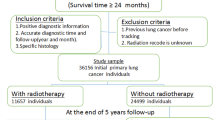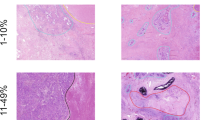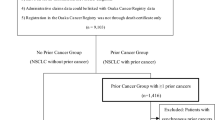Abstract
Retrospective analysis of data from 14,528 lung cancer patients with multiple primary malignant neoplasm (MPMN) revealed that 2.5% (364/14,528) were MPMN cases and 96.2% (350/364) were diagnosed with two primary malignancies, 3.6% (13/364) with three primary malignancies, and 0.3% (1/364) with four primary malignancies. Among 350 lung cancer patients diagnosed with two primary malignancies, 26.6% (93/350) had lung cancer diagnosed first (LCF) and 73.4% (257/350) had other cancers diagnosed initially (OCF), whereas synchronous MPMN (SMPMN) accounted for 21.1% (74/350) and metachronous MPMN (MMPMN) accounted for 78.9% (276/350) of the cases. Detection of first primary neoplasms were at an early stage for LCF patients and the age of the first lung cancer diagnosis was 59.3 years vs. 55.4 years in the OCF group (P = 0.008), whereas the onset age of second primary neoplasm diagnosis was similar in both groups (62.5 and 61.6 years, P = 0.544). Median survival times of MMPMN and SMPMN patients in the LCF group were 6.83 and 2.42 years and in the OCF group 8.67 years and 2.25 years, respectively. Multivariate analysis showed that SMPMN, LCF and the age of the primary cancer diagnosed first ( ≥ 60 years) and NSCL staging > II were significant independent factors for inferior prognosis of patients.
This is a preview of subscription content, access via your institution
Access options
Subscribe to this journal
Receive 12 print issues and online access
$259.00 per year
only $21.58 per issue
Buy this article
- Purchase on Springer Link
- Instant access to full article PDF
Prices may be subject to local taxes which are calculated during checkout


Similar content being viewed by others
Data availability
All data generated or analyzed during this study are included in this published article.
References
Chen W, Zheng R, Zeng H, Zhang S. Epidemiology of lung cancer in China. Thorac Cancer. 2015;6:209–15.
Fan H, Shao ZY, Xiao YY, Xie ZH, Chen W, Xie H, et al. Incidence and survival of non-small cell lung cancer in Shanghai: a population-based cohort study. BMJ Open. 2015;5:e009419.
Levi F, Randimbison L, Rafael BM, Manuela MC, La Vecchia C. Second primary cancers in the Vaud and Neuchatel Cancer Registries. Eur J Cancer Prev. 2015;24:150–4.
Koubkova L, Hrstka R, Dobes P, Vojtesek B, Vyzula R. Second primary cancers—causes, incidence and the future. Klin Onkol. 2014;27:11–7.
Tabuchi T, Ito Y, Ioka A, Miyashiro I, Tsukuma H. Incidence of metachronous second primary cancers in Osaka, Japan: update of analyses using population-based cancer registry data. Cancer Sci. 2012;103:1111–20.
Warren S, Gates O. Multiple primary malignant tumors: a survey of the literature and a statistical study. Cancer. 1932;16:1358–414.
Edge SB, Compton CC. The American Joint Committee on Cancer: the 7th edition of the AJCC cancer staging manual and the future of TNM. Ann Surg Oncol. 2010;17:1471–4.
Li F, Zhong WZ, Niu FY, Zhao N, Yang JJ, Yan HH, et al. Multiple primary malignancies involving lung cancer. BMC Cancer. 2015;15:696.
Jiao F, Yao LJ, Zhou J, Hu H, Wang LW. Clinical features of multiple primary malignancies: a retrospective analysis of 72 Chinese patients. Asian Pac J Cancer Prev Apjcp. 2014;15:331–4.
Papajik T, Myslivecek M, Sedova Z, Buriankova E, Prochazka V, Raida L, et al. Synchronous second primary neoplasms detected by initial staging F-18 FDG PET/CT examination in patients with non-Hodgkin lymphoma. Clin Nucl Med. 2011;36:509–12.
Fujita S, Masago K, Takeshita J, Togashi Y, Hata A, Kaji R, et al. Multiple primary malignancies in patients with non-small cell lung cancer. Intern Med. 2015;54:325–31.
Naylor GM, Gotoda T, Dixon M, Shimoda T, Gatta L, Owen R, et al. Why does Japan have a high incidence of gastric cancer? Comparison of gastritis between UK and Japanese patients. Gut. 2006;55:1545–52.
Liu S, Dai JY, Yao L, Li X, Reid B, Self S, et al. Esophageal adenocarcinoma and its rare association with Barrett’s esophagus in Henan, China. PLoS ONE. 2014;9:e110348.
Kimura T. East meets West: ethnic differences in prostate cancer epidemiology between East Asians and Caucasians. Chin J Cancer. 2012;31:421–9.
Merrill RM, Feuer EJ. Risk-adjusted cancer-incidence rates (United States). Cancer Causes Control. 1996;7:544–52.
Schenker JG, Levinsky R, Ohel G. Multiple primary malignant neoplasms in breast cancer patients in Israel. Cancer. 1984;54:145–50.
Grantzau T, Thomsen MS, Væth M, Overgaard J. Risk of second primary lung cancer in women after radiotherapy for breast cancer. Radiother Oncol. 2014;111:366–73.
Walton A, Broadbent AL. Radiation-induced second malignancies. J Palliat Med. 2008;11:1345–52.
Liu YY, Chen YM, Yen SH, Tsai CM, Perng RP. Multiple primary malignancies involving lung cancer-clinical characteristics and prognosis. Lung Cancer. 2002;35:189–94.
Hsieh W-C, Chen Y-M, Perng R-P. Temporal relationship between cancers of the lung and upper aerodigestive tract. Jpn J Clin Oncol. 1997;27:63–6.
Funding
This work was supported by Establishment of Lung Cancer Database in Henan.
Author information
Authors and Affiliations
Contributions
HW, JH, and ZM were responsible for the conception and design of the study. JH, GZ, MZ, PL, and XY were responsible for acquisition and analysis of data; furthermore, JH, MZ, and XY were in charge of statistical analysis. HW, HJ, GZ, and ZM drafted the manuscript; HW and ZM revised and commented the draft, and HW, MZ, and ZM approved the final version of the manuscript.
Corresponding author
Ethics declarations
Conflict of interest
The authors declare that they have no conflict of interest.
Consent for publication
Consent for publication was obtained from all patients.
Ethics approval and consent to participate
The ethical committee of the Henan Cancer Hospital approved this study and written informed consent was obtained from all patients.
Additional information
Publisher’s note: Springer Nature remains neutral with regard to jurisdictional claims in published maps and institutional affiliations.
Supplementary information
41417_2019_84_MOESM1_ESM.docx
Supplementary Table 1. Distribution of concomitant malignancies in 350 MPMN patients with lung cancer (number of cases %)
Rights and permissions
About this article
Cite this article
Wang, H., Hou, J., Zhang, G. et al. Clinical characteristics and prognostic analysis of multiple primary malignant neoplasms in patients with lung cancer. Cancer Gene Ther 26, 419–426 (2019). https://doi.org/10.1038/s41417-019-0084-z
Received:
Revised:
Accepted:
Published:
Issue Date:
DOI: https://doi.org/10.1038/s41417-019-0084-z
This article is cited by
-
Clinical characteristics and survival of glioblastoma complicated with non-central nervous system tumors
Chinese Neurosurgical Journal (2022)



